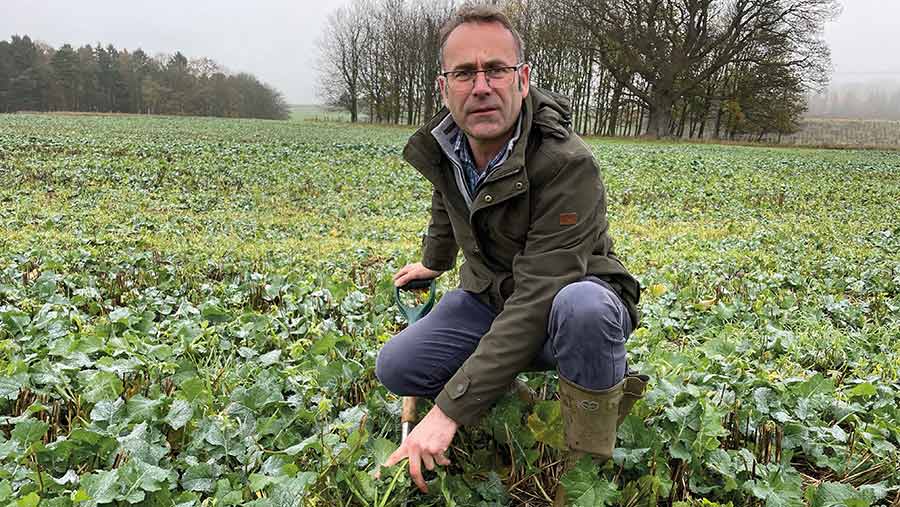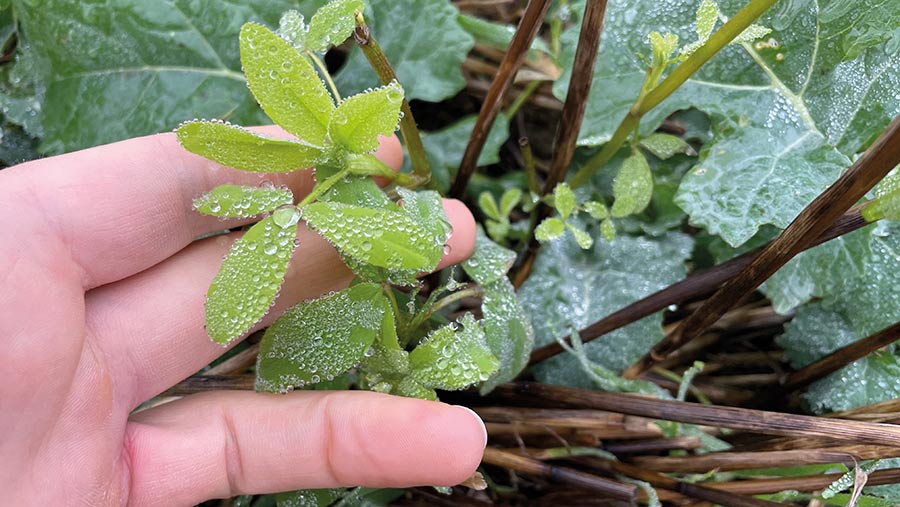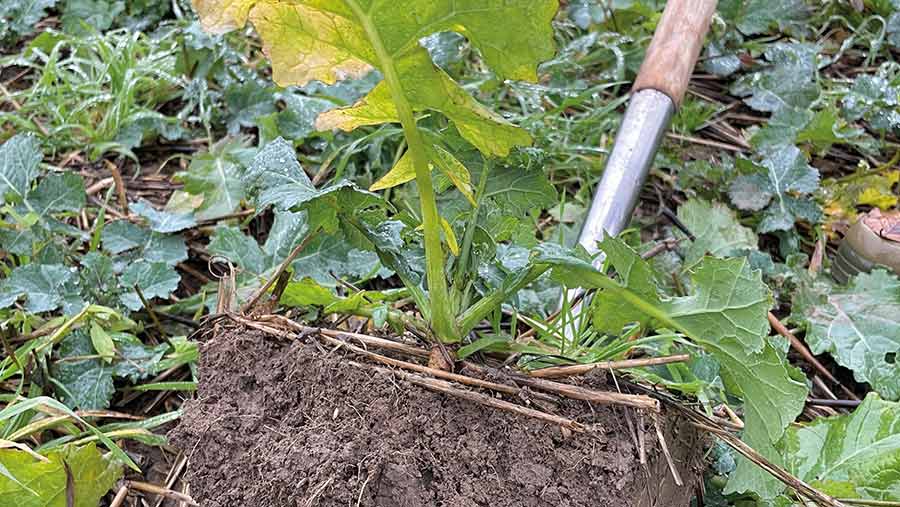County Durham estate uses biologicals to reduce fungicide input
 Phil Vickers inspecting his oilseed rape crop © Adam Clarke
Phil Vickers inspecting his oilseed rape crop © Adam Clarke County Durham farm manager Philip Vickers is on a mission to implement what he hopes will be a sustainable farming system for generations to come.
Part of the system’s approach is to reduce synthetic pesticide use and increase involvement in a collaborative project that is conducting farm scale trials with biological fungicides, which produced some encouraging results in 2022.
While there is little chance of him relying solely on such products in the short term, the results show Mr Vickers may be able to reduce his farm standard fungicide input by a third, depending on risk each spring, offering both economic and environmental benefits.
See also: Why cutting N fertiliser is a bigger challenge this season
Best practice
Mr Vickers has had an interesting journey into his current role heading the farm operations on the Raby Estate, which covers a significant area from the River Tees in the south up to land around Raby Castle near Staindrop.
When he left his job at a major distribution agronomy group in 2014, Mr Vickers had become disillusioned with the input-heavy farming systems widely deployed across the UK.
The UK arable area had been hit by periods of extreme cold, extreme drought and extreme wet, and it was clear which farm businesses had coped better than others.
“The key was carbon – generally, those farms with more of it in their soils were more resilient,” says Mr Vickers.
He also notes the trend for ever more powerful tractors on arable units, which he believes correlates with depletion of soil organic matter and soil structure.
“Before I went into agronomy, we’d have 100hp on a four-furrow plough. Now it’s not uncommon to have 300hp on five furrows. Something has gone drastically wrong,” he says.
Breaking convention
As well as running his own consultancy business, advising both conventional clients and those trying to break away to a new approach, Mr Vickers also managed the arable area on the family farm.
He had trialled companion cropping, bi-cropping, novel nutritional approaches, and direct drilling, long before he recommended these approaches to the bulk of his clients.
Mr Vickers successfully switched the family farm to direct drilling, along with those of his clients who wanted to make the change, while looking for ways to reduce reliance on synthetic fertiliser and plant protection products.
This was inspired by some famous names such as US regen pioneer Gabe Brown, Australian crop nutrition expert Graeme Sait and US soil microbiologist Kristine Nichols, who he met at a Base UK event.
He says: “I don’t like the term ‘regen’ agriculture, as it means a lot of things to different people. I think it is just about trying to implement best farm practice in everything we do and accepting that not all solutions come from a can or bag.
“That’s not to say that synthetic inputs aren’t important, as we certainly wouldn’t want to lose them, but we need to think about the bigger picture and use inputs more carefully,” he explains.

© Adam Clarke
Estate evolution
Along with a change in circumstances on the family farm, this shifting ethos led him to take on the challenging task of implementing owner Lord Barnard’s vision for revamping Raby Estate’s farming system.
Like many large family-owned estates with in-hand farming operations, environmental sustainability has become as important as the economics for the estate.
Mr Vickers must now make the system work across a significant area, with the autumn of 2021 his first cropping cycle as Raby’s farm manager.
That year about 17% of the arable area was direct-drilled, with the availability of machinery the only factor stopping it being significantly higher.
With the arrival of a Horsch Avatar to work alongside a Seedhawk tine drill, this season that figure has jumped to 90%. All crops established well in the autumn, with wheat crops thick and lush heading into spring.
In a short time Mr Vickers has seen significant improvements to soils by reducing tillage and enforcing a strict policy of sticking to tramlines for post-harvest traffic such as straw trailers.
“Increasing organic matter will take a long time, but improvements in soil structure and biology can be achieved relatively quickly with the right management,” he says.
Continuing soil improvements will be a key priority in the long-term, and will be achieved by continuing with direct drilling, although some land will be ploughed ahead of spring barley to help keep on top of grassweeds, particularly brome.

© Adam Clarke
Stock integration
There will also be a move for closer integration with the estate’s livestock enterprises, which include a flock of 500 ewes and a 125-head Longhorn and Angus suckler herd. There is also a small herd of White Galloways.
As well as improvements below ground, Mr Vickers has been looking for ways to manage crops in a more efficient and environment-sensitive way.
He was aware of liquid sulphur being used as a fungicide for many years, and after a conversation with Adas fungicide expert Jonathan Blake, was interested to see what the novel sulphur formulation Thiopron could offer to septoria control programmes in winter wheat.
Manufacturer UPL also offers the laminarin-based elicitor product Iodus – which contains a polysaccharide extracted from brown seaweed – and Mr Vickers was also excited by its potential to reduce reliance on synthetic fungicides.
“It’s an alternative to conventional chemistry and we constantly need to be looking and evaluating these things to improve what we are doing,” he says.
Tramline trials
Last year the estate joined UPL’s biosolutions project – an initiative that has been testing Thiopron and Iodus in tramline trials across a handful of Norfolk farms since spring 2021.
Raby Estate’s 2022 trial compared three programmes applied to Limagrain Group 4 feed wheat variety Spotlight, which has only a moderate septoria resistance score of 5.1 on the AHDB Recommended List.
Treatment list for spring 2022 |
|||
|
|
Treatment 1 – Biosolutions only |
Treatment 2 – Reduced farm standard + biosolutions (one-third less conventional fungicide) |
Treatment 3 – Farm standard |
|
T0 |
N/A |
N/A |
N/A |
|
T1 |
Thiopron 3 litres/ha |
Fluxapyroxad + mefentrifluconazole 0.6 litres/ha |
Fluxapyroxad + mefentrifluconazole 0.9 litres/ha |
|
T2 |
Thiopron 3 litres/ha |
Mefentrifluconazole + pyraclostrobin 0.66 litres/ha, Thiopron 3 litres/ha |
Mefentrifluconazole + pyraclostrobin 1 litre/ha |
Ahead of the key spring fungicide application period, Mr Vickers decided to introduce sheep onto some of the wheat trial area to graze it back.
The trigger was the Russian invasion of Ukraine, which brought a massive increase in nitrogen fertiliser prices, so he wanted to see if this could help reduce N requirement and potentially help with foliar disease management.
The grazing meant no T0 product was applied in the 2022 protocol. However, the estate did use Iodus over a sizeable area of land at T0 and Mr Vickers has no reservations about using the product again.
“It appealed because it’s cost effective, and as 2022 was relatively low-pressure year we thought it was worth trying something new.
“I can’t put any scientific data behind it, but my gut feeling is that Iodus – combined with the nutritional mix we applied with it – set the crops up well. I’d have no qualms this year, even if it turns out to be a high-pressure season,” he says.
Trials results
The results from the biosolutions trials were collected and collated by Adas and showed some interesting differences between treatments.
Severity of foliar diseases and green leaf area (GLA) were assessed in early July.
In both the grazed and ungrazed areas, the farm standard and reduced farm standard with biosolutions consistently reduced the severity of septoria, powdery mildew and yellow rust compared with the biosolutions alone.
Adas researcher Rebecca Joynt also noted that the combination of reduced farm standard and biosolutions often appeared to produce lower levels of disease than the farm standard and was significant for septoria on all leaves.
Looking at GLA, the reduced farm standard with biosolutions consistently maintained more than the biosolutions alone, and tended to maintain more GLA than the farm standard. In some cases, this was significant.
Across all the fungicide treatments, grazing had little effect on the severity of septoria or yellow rust or the maintenance of GLA, but there appeared to be significantly more powdery mildew on leaves 2 and 3 where grazed.
This is because the disease favours lush new growth, which would have been stimulated by plants being grazed back by the sheep in the early spring.
Interestingly, there was a significant yield response from grazing, with grazed areas producing a much higher average than ungrazed, which Mr Vickers suspects is a result of increased tillering.
This spring
So, how will this influence management of the estate’s crops this spring? Mr Vickers notes that 2022 was a low disease pressure year and that will be a factor in his decision-making for 2023.
However, he is encouraged by the reduced farm standard with biological treatment, which has the potential to give an uplift in yield, a reduction in disease, less cost, and less fungicide resistance risk.
The important decision is how much of the conventional chemistry to cut out of the programme when the risk is high, but that must be made as close to application time as possible.
“If we could be using 33% less by adding a biological and the right nutrients into the system, it’s massively exciting. We do need some more experience though, and that’s why we are staying in the project this year,” he adds.
On grazing, he sees it as something that will need careful management, with satellite NVDI imagery showing that about half the canopy was removed.
“It’s not something we will do on a large scale yet, as we haven’t got the stock numbers and enough data behind us, but we will continue to look at it.”
Biosolutions trials: What did the sites show in 2022?
Manufacturer UPL has been running trials since 2021 to test how biological products such as Iodus (laminarin) and Thiopron (sulphur) can be incorporated into winter wheat disease control programmes.
Holkham Estate in Norfolk continued with the trials in 2022, when it was joined by Robinsons Farms near Kings Lynn, and Raby Estate in County Durham.
The initiative uses the Adas agronomics tramline trial service, which provides scientific advice on the setup and execution of on-farm experiments, along with data collection and analysis.
Key messages from across the sites for 2022 include:
- The farm standards plus biologicals tended to give greater control of septoria and green leaf area (GLA) retention than either farm standard or biological treatments alone.
- Farm standard treatments gave greater control of septoria and GLA than biological treatments alone.
- Yield analysis indicated comparable performance of all treatments.
- Yield data was variable because of the low disease pressure and prolonged dry spell/early senescence due to heatwaves, so should be treated with caution.

